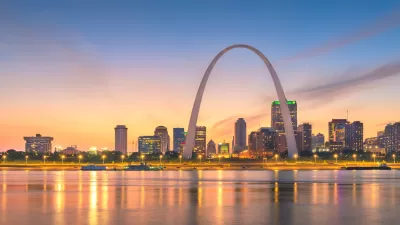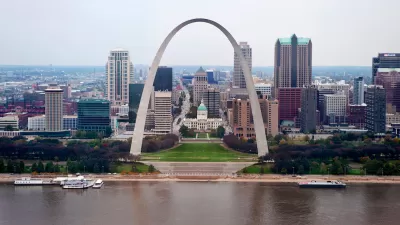The winner of a competition to design the Chouteau Greenway in St. Louis hopes landscape architecture can inspire a larger conversation about race and class.
Zach Mortice reports in detail on plans for the Chouteau Greenway, under development by the Great Rivers Greenway, a regional public agency. The ambition of the project is undeniable:
The Chouteau Greenway (pronounced “show-toe”), which is planned to run about five miles from Forest Park on St. Louis’s western edge to the newly rejuvenated Gateway Arch National Park at the Mississippi River, is not a park. It’s not even a park system. It’s a landscape-driven development strategy for an entire swath of the city. Its goal is to break down the city’s stark north-south racial divide [pdf] by attracting St. Louisans from across a socioeconomic spectrum toward a corridor defined by a tangle of transit infrastructure. Along the way are some of the region’s most eminent education, medical, and cultural institutions.
The Great Rivers Greenway recently concluded a design competition, won by the Boston- and Los Angeles-based urban design firm Stoss. The Great Rivers Greenway "hopes to have a refined concept from Stoss by midsummer, though there is no money yet for implementation," reports Mortice. The article includes a lot more on the ambitions of the project as well as renderings and other visual materials included in the Stoss's winning submittal.
FULL STORY: A “LOOP AND A STITCH” ACROSS ST. LOUIS’S DIVIDE

Trump Administration Could Effectively End Housing Voucher Program
Federal officials are eyeing major cuts to the Section 8 program that helps millions of low-income households pay rent.

Planetizen Federal Action Tracker
A weekly monitor of how Trump’s orders and actions are impacting planners and planning in America.

Ken Jennings Launches Transit Web Series
The Jeopardy champ wants you to ride public transit.

Crime Continues to Drop on Philly, San Francisco Transit Systems
SEPTA and BART both saw significant declines in violent crime in the first quarter of 2025.

How South LA Green Spaces Power Community Health and Hope
Green spaces like South L.A. Wetlands Park are helping South Los Angeles residents promote healthy lifestyles, build community, and advocate for improvements that reflect local needs in historically underserved neighborhoods.

Sacramento Plans ‘Quick-Build’ Road Safety Projects
The city wants to accelerate small-scale safety improvements that use low-cost equipment to make an impact at dangerous intersections.
Urban Design for Planners 1: Software Tools
This six-course series explores essential urban design concepts using open source software and equips planners with the tools they need to participate fully in the urban design process.
Planning for Universal Design
Learn the tools for implementing Universal Design in planning regulations.
Heyer Gruel & Associates PA
Ada County Highway District
Institute for Housing and Urban Development Studies (IHS)
City of Grandview
Harvard GSD Executive Education
Toledo-Lucas County Plan Commissions
Salt Lake City
NYU Wagner Graduate School of Public Service





























